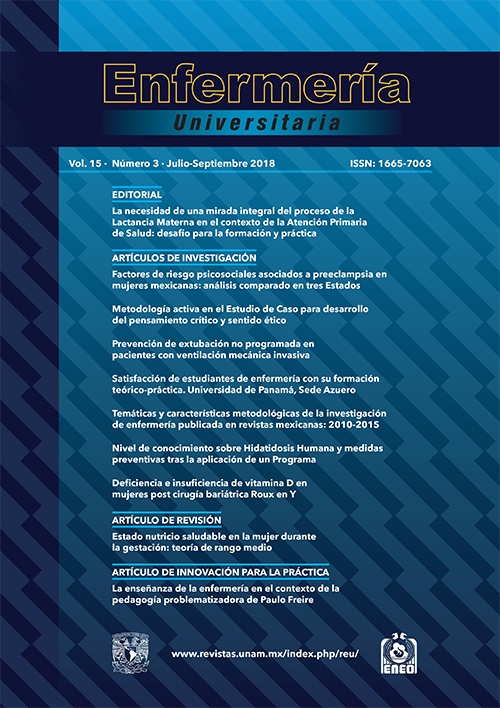Psychosocial risk factors associated to pre-eclampsia among mexican women: a comparative analysis in three States
Main Article Content
Abstract
Objective: To comparatively analyze the psychosocial risk factors associated to pre-eclampsia among Mexican women living in three States.
Method: This is a cases and controls study with 336 pregnant women with and without pre-eclampsia (130 from the State of Mexico, 114 from the state of Yucatan, and 92 from the state of Veracruz). Two questionnaires were administered, and 5 previously validated Likert type scales were used. A statistical comparative analysis was performed using SPSS v.20 software. Quantitative variables were analyzed with the Kruskal-Wallis procedure, categorical variables with frequencies calculation, and the associated risk with odds ratios in the 95% confidence interval. The associated risk was further adjusted through logistic regression (a = 0.05).
Results: The analysis revealed a mild level of violence in all three States. States which reflected more frequency of violence risks were Mexico and Veracruz (OR: 3.53; IC 95%: 1.13 - 10.97). Depression was a significant finding associated to pre-eclampsia. A 1 to 2 times higher risk of associated pre-eclampsia was found among pregnant women with some degree of depression in the State of Mexico (OR: 1.66; IC 95%: 1.058 - 2.607), and this risk was 3 to 4 times higher in the presence of major depressive disorder (OR: 3.67; IC 95%: 1.23 - 10.89). Among women from the state of Veracruz who sometimes reported having depressive symptoms, the risk of pre-eclampsia association was 3 times higher (OR: 3.12; IC 95%: 1.077 - 9.083), while this risk was 7.4 times higher when these women had less than 5 prenatal assessment visits (OR: 7.42; IC 95%: 2.85 - 19.33).
Conclusions: Depression, depressive symptomatology, violence, and less-than-5 prenatal assessment visits were all identified as psychosocial risk factors associated to pre-eclampsia. These findings will support proposals for a corresponding nursing integral intervention model to address the related risk factors.
Publication Facts
Reviewer profiles N/A
Author statements
- Academic society
- N/A
- Publisher
- Universidad Nacional Autónoma de México
Article Details
Dimensions citation
MÉTRICAS

This work is licensed under a Creative Commons Attribution-NonCommercial-NoDerivatives 4.0 International License.
Enfermería Universitaria by Universidad Nacional Autónoma de México it is distributed under the License Creative Commons Attribution - NonCommercial - NoDerivatives 4.0 International
Accepted and published articles become open-access under the terms of the Creative Commons CC BY-NC-ND 4.0 license, which authorizes the reproduction and sharing without commercial purposes, provided the corresponding acknowledgments to their authors. Authors are allowed to manage a self-archive copy of the article’s published version so that they can open-access it in their personal or institutional web pages, and/or any other broad-diffusion space.


